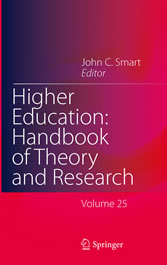
Higher Education: Handbook of Theory and Research - Volume 25

von: John C. Smart
Springer-Verlag, 2010
ISBN: 9789048185986
Sprache: Englisch
587 Seiten, Download: 5034 KB
Format: PDF, auch als Online-Lesen
"Cultural Perspectives of Academia: Toward a Model of Cultural Complexity (p. 381-382)
Ryan E. Smerek
Introduction
Throughout the past 20 years cultural analysis has flourished as a means of studying higher education organizations (Cameron & Ettington, 1988; Kuh & Whitt, 1988; Masland, 1985; Peterson, Cameron, Jones, Mets, & Ettington, 1986; Peterson, Cameron, Knapp, Spencer, & White, 1991; Peterson & Spencer, 1990, 1993; Silver, 2003; Smart, 2003; Smart & St. John, 1996; Smart, Kuh, & Tierney, 1997). Not only has it been of interest to organizational scholars but also to administrators for its potential to improve administrative action (Austin, 1990; Chaffee & Tierney, 1988; Dill, 1982; Tierney, 1988).
Ultimately, cultural analysis is important because it can lead to insightful interpretations of organizations, management, and working life. A cultural perspective offers powerful ways to understand deep-level, partly non-conscious sets of meanings, ideas, and symbols. Cultural analysis of higher education organizations began in the 1960s (Clark, 1963a; Clark & Trow, 1966), and in a novel insight at the time, Riesman and Jencks say, “to the extent that a college is a subculture, with its own idiosyncratic customs and concerns, an anthropologist can study it in much the same way that he studies a primitive tribe or modern community” (1962, p. 104).
However, it was not until the late 1980s that a cultural perspective rapidly expanded (Allaire & Firsirotu, 1984; Barley, Meyer, & Gash, 1988; Denison, 1990; Weick, 1985). To some degree the interest in culture was a secondary wave from its prominence in the early 1980s in business organizations. Culture came to be seen by business managers as the key to Japan’s economic success (Ouchi & Jaeger, 1978; Ouchi & Wilkens, 1985; Pettigrew, 2000).
It was also seen by organizational scholars as a new perspective for those tired of sterile, scientific methods to understanding organizations (Alvesson, 1993; Ashkanasy, Wilderom, & Peterson, 2000; Jelinek, Smircich, & Hirsch, 1983; Schein, 1996; Smircich, 1983). The key books in the early 1980s that propelled the subject onto center stage were Ouchi’s Theory Z (1981), where he describes the holistic concern for the physical and psychological well-being of the employee—an approach he saw among Japanese companies. Additionally, In Search of Excellence (1982) by Peters and Waterman and Corporate Cultures (1982) by Deal and Kennedy played prominent roles in the perspective’s ascendancy."







